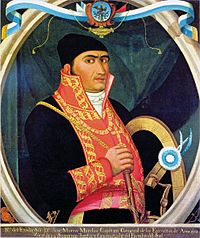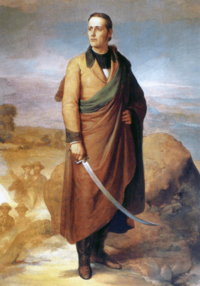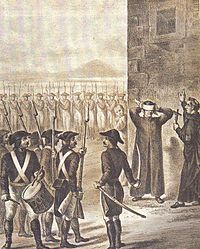Battle of Lomas de Santa María facts for kids
Quick facts for kids Battle of Lomas de Santa María |
|||||||
|---|---|---|---|---|---|---|---|
| Part of the Mexican War of Independence | |||||||
 A map of the fifth and final campaign of José María Morelos, where the Battle of Lomas de Santa María took place. |
|||||||
|
|||||||
| Belligerents | |||||||
| Commanders and leaders | |||||||
| Félix María Calleja Agustín Cosme Damián de Iturbide y Arámburu Ciriaco del Llano Domingo Landázuri |
|||||||
| Strength | |||||||
| 5,600 soldiers | 1,200 soldiers | ||||||
| Casualties and losses | |||||||
| 789 | 200 | ||||||
The Battle of Lomas de Santa María was an important fight during the Mexican War of Independence. It happened from December 23 to 24, 1813. The battle took place near Lomas de Santa María, which is now part of Morelia (then called Valladolid). This battle was fought between Mexican rebels, who wanted independence, and the Spanish royalist forces, who were loyal to the King of Spain.
The battle started when about 5,600 Mexican rebels attacked the city of Valladolid. Their leaders included José María Morelos y Pavón, Mariano Matamoros y Guridi, Nicolás Bravo, and Hermenegildo Galeana. They attacked on December 23 after the Spanish leaders refused to give up the city.
The Spanish forces were led by Agustín Cosme Damián de Iturbide y Arámburu, who later became an emperor of Mexico. The battle lasted almost two days. In the end, the Spanish royalists won. The fight changed when more Spanish soldiers arrived from Mexico City. These reinforcements were sent by the Viceroy of New Spain, Félix María Calleja, and led by Ciriaco del Llano. Around midnight, the royalist soldiers managed to get into the rebel camp. This forced the rebels to run away in a disorganized way. This battle was a big turning point. It marked the beginning of the end for Morelos's successful military actions in the war.

Why the Battle Happened

The Mexican War of Independence began when Mexico declared its freedom from Spain. José María Morelos y Pavón, a priest, met with another rebel leader, Miguel Hidalgo y Costilla, in 1810. Morelos was given the job of fighting the Spanish in southern Mexico. His main goal was to capture the port city of Acapulco de Juárez. After Hidalgo was captured and executed in 1811, Morelos became the main leader of the rebels.
Morelos's forces had some important victories. They successfully defended Cuautla against Spanish attacks. They also captured the city of Oaxaca de Juárez in 1812. In September 1813, the rebels held a meeting called the Congress of Chilpancingo. During this meeting, they heard that Acapulco had finally been captured. The Congress then decided that the rebels should try to capture Valladolid (today's Morelia). They wanted to move their government to that city. So, in November, the rebel army marched towards Valladolid, arriving in December.
The Battle Begins
The Spanish leader, Félix María Calleja, had a good spy network. He quickly found out about the rebels' plans to take Valladolid. He knew where Morelos was moving his troops. On December 8, Calleja ordered Colonel Domingo Landázuri to leave Mexico City with 1,000 soldiers. Colonel Agustín de Iturbide and General Ciriaco del Llano joined Landázuri's forces. They all met up on December 23. Landázuri then marched directly to Valladolid to prepare for the rebel attack.
Ramón López Rayón told Morelos about the Spanish troop movements. Morelos ordered Rayón to attack Iturbide and Llano's forces. This was to buy time for Morelos's own troops to reach and capture Valladolid. Morelos knew he had to capture the city quickly. He wanted to do it before more Spanish soldiers arrived from Mexico City. Rayón's forces fought Iturbide's army on December 21. The rebels were pushed back. During this fighting, Rafael López Rayón, the son of the rebel commander, was killed.
On the morning of December 23, Morelos sent a message to Landázuri. He asked Landázuri to surrender Valladolid. Morelos promised to spare the lives of the Spanish commander and his soldiers. But Landázuri ignored the offer. He waited for the attack.
Around midday, a rebel group led by Hermenegildo Galeana began its attack on Valladolid. Galeana had just over 1,000 soldiers. They entered the city from the north. They quickly defeated the Spanish soldiers defending that area. For a short time, it looked like Landázuri's forces were surrounded. About two hours later, Iturbide and Llano arrived with their reinforcements. They immediately started fighting Galeana's attacking forces. Galeana decided to pull back because he realized he couldn't take the city. Llano wanted to chase Galeana, but Iturbide stopped him. Iturbide thought chasing them would be a mistake. Galeana went back to Morelos's camp and asked for more soldiers.
Nicolás Bravo decided to try attacking the city again with his own soldiers. But Llano and his troops stopped Bravo in the city center. Bravo's attack was also pushed back. Mariano Matamoros led the third and final attempt to take the city. His attack failed just like the first two.
After hearing about Matamoros's defeat, Morelos sent a messenger. He told Matamoros to return to camp. They planned to try taking the city again the next day. The rebels camped in a thick forest outside Valladolid. This area was known as the Lomas de Santa María.
Around midnight on December 24, Iturbide found the rebel camp. Llano convinced him to attack right away. They didn't want the rebels to attack the city again the next day. Around 2 AM, Llano and Iturbide attacked the rebel camp. They killed about a quarter of Morelos's soldiers. Because it was dark and confusing, the rebel soldiers kept firing at each other even after the Spanish troops had left. The rebels ran away in a panic. This defeat marked the end of Morelos's fourth military campaign. It led to his fifth campaign, where he was eventually captured and executed in 1815.
What Happened Next
After this big loss, Morelos decided to pull his forces back from Valladolid. He gave up on trying to capture the city. He retreated to Puebla and planned to continue fighting at Puruarán. On January 4, 1814, Matamoros led a group of rebels at the Battle of Puruarán. He fought against an army led by Iturbide. Llano had already been called back to Spain.
Matamoros's forces were completely defeated at Puruarán. Matamoros himself was captured by a Spanish soldier. He was taken prisoner and sentenced to death on January 23. Morelos tried to save Matamoros's life. He offered to trade 200 captured Spanish soldiers for Matamoros. But the Spanish leader refused this offer. Matamoros was executed on February 3, 1814. When Morelos found out about Matamoros's execution, he ordered that all 200 Spanish prisoners be put to death. Morelos himself was captured and executed by the Spanish a year later, in 1815.
See also
 In Spanish: Batalla de las Lomas de Santa María para niños
In Spanish: Batalla de las Lomas de Santa María para niños


